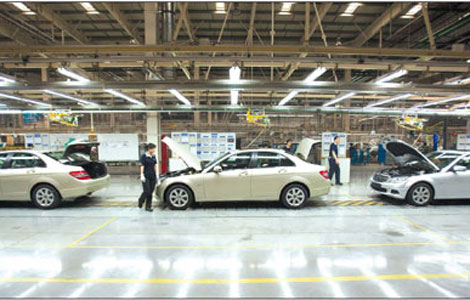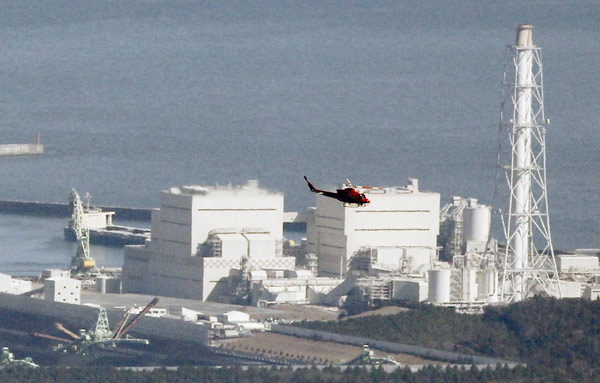Asia
Explosion at Japan's quake-hit nuclear plant - media
Updated: 2011-03-12 18:12
(Agencies)
|
|
TOKYO - An explosion blew the roof off an unstable reactor north of Tokyo on Saturday, Japanese media said, raising fears of a disastrous meltdown at a nuclear plant damaged in the massive earthquake that hit Japan.
The 8.9-magnitude earthquake -- the strongest ever recorded in Japan -- sent a 10-metre tsunami ripping through towns and cities across the northeast coast. Japanese media estimate that at least 1,300 people were killed.
Jiji news agency said there had been an explosion at the stricken 40-year-old Daichi 1 reactor and TV footage showed vapour rising from the plant, which lies 240 km (150 miles) north of Tokyo.
The blast came as plant operator Tokyo Electric Power Co (Tepco) worked desperately to reduce pressures in the core of the reactor that -- if not contained -- could lead to a release of radiation into the atmosphere.
"An unchecked rise in temperature could cause the core to essentially turn into a molten mass that could burn through the reactor vessel," risk information service Stratfor said in a report. "This may lead to a release of an unchecked amount of radiation into the containment building that surrounds the reactor."
NHK television and Jiji said the outer structure of the building that houses the reactor appeared to have blown off, which could suggest the containment building had already been breached.
Earlier the operator released what it said was a tiny amount of radioactive steam to reduce the pressure and the danger was minimal because tens of thousands of people had already been evacuated from the vicinity.
Italy's National Institute of Geophysics and Volcanology said the earth's axis had shifted 25 cm as a result of the quake and the U.S. Geological Survey said the main island of Japan had actually shifted 2.4 metres.
Thousands flee
Friday's tremor was so huge that thousands fled their homes from coastlines around the Pacific Rim, as far away as North and South America, fearful of a tsunami.
Most appeared to have been spared anything more serious than some high waves, unlike Japan's northeast coastline which was hammered by the huge tsunami that turned houses and ships into floating debris as it surged into cities and villages, sweeping aside everything in its path.
"I thought I was going to die," said Wataru Fujimura, a 38-year-old sales representative in Koriyama, Fukushima, north of Tokyo and close to the area worst hit by the quake.
"Our furniture and shelves had all fallen over and there were cracks in the apartment building, so we spent the whole night in the car... Now we're back home trying to clean."
The unfolding natural disaster, which has been followed by dozens of aftershocks, prompted offers of search and rescue help from 50 countries.
The central bank said it would cut short a two-day policy review scheduled for next week to one day on Monday and promised to do its utmost to ensure financial market stability.
The disaster struck as the world's third-largest economy had been showing signs of reviving from an economic contraction in the final quarter of last year. It raised the prospect of major disruptions for many key businesses and a massive repair bill running into tens of billions of dollars.
In one of the worst-hit residential areas, people buried under rubble could be heard calling out for rescue, Kyodo news agency reported. TV footage showed staff at one hospital waving banners with the words "FOOD" and "HELP" from a rooftop.
In Tokyo, tens of thousands of office workers were stranded overnight after the quake shut down public transport. Many were forced to bed down where they could, with newspapers to lie on and briefcases for pillows.
Kyodo said at least 116,000 people in Tokyo had been unable to return home on Friday evening due to transport disruption.
The airport in coastal city Sendai, home to one million people, was on fire, Japanese media said.
"Sendai (city) is now completely sunk underwater," said limousine driver Yoshikatsu Takayabe, 52. "What do I want the government to do? I can't flush the toilet, I want the water back on in my house."
TV footage from Friday showed a black torrent of water carrying cars and wrecked homes at high speed across farmland near Sendai, 300 km (180 miles) northeast of Tokyo. Ships had been flung onto a harbour wharf, where they lay helplessly.
Kyodo news agency reported that contact had been lost with four trains in the coastal area.
The earthquake was the fifth most powerful to hit the world in the past century. It surpassed the Great Kant quake of September 1, 1923, which had a magnitude of 7.9 and killed more than 140,000 people in the Tokyo area.
The 1995 Kobe quake caused $100 billion in damage and was the most expensive natural disaster in history.
E-paper

Factory fever
Despite auto manufacturing bubble scare, car giants gear up expansion of factories.
Dressed for success
Fabric of change
High spirits
Specials

Earthquake Hits Japan
A massive 8.8 magnitude quake hit the northeast coast of Japan on March 11,2011.

NPC & CPPCC sessions
Lawmakers and political advisers gather in Beijing to discuss major issues.

Panda campaign
Black-and-white bear helps Chengdu in marketing campaign after quake.

